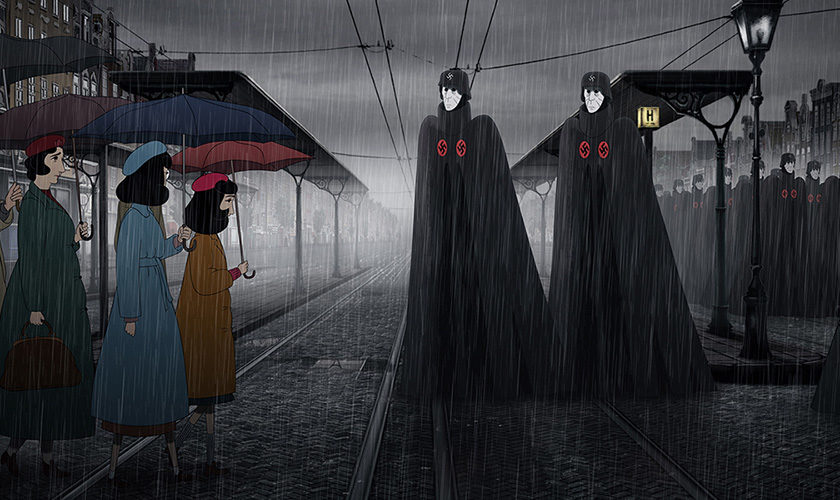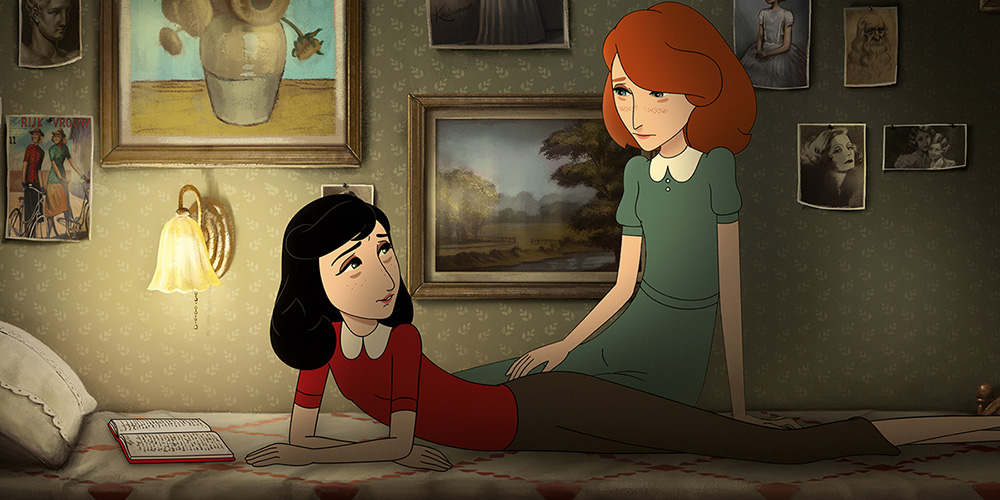Everything is Anne Frank.
The premise to Ari Folman‘s Where Is Anne Frank is genius. Rather than adapt the famed diary into a traditional narrative, he brings its target (Anne’s imaginary friend Kitty) to life. And since this figment of a sounding board only knows that which Anne (Emily Carey) wrote to her, finding form in the present is obviously going to leave many important holes. How did the war end? How long did it last? Did Anne become a famous writer? Did she and Peter van Daan ever have a real date? And where even has she gone? Kitty (Ruby Stokes) tries to ask the hundreds of people walking through the old Annex hiding place daily, but no one seems to see her. So she takes the diary and heads outside.
Once removed from what has now become a museum, she can finally get some answers—as long as she doesn’t get too far from the diary and fade away. She goes to the police station to file a missing person’s report for a young girl the entire town has been rebranded to honor, makes a new friend in a pickpocket named Peter (Ralph Prosser), and ultimately discovers the past hasn’t yet taught the present quite as many lessons as one would hope. It’s the latter part where Folman starts to bite off a bit more than he can chew en route to a subplot reminding the world what Anne’s message truly meant as far as surviving war-torn nations as refugees abroad. Protecting innocent children should never be out-of-bounds.

Take that away (it’s not a failed diversion as much as a half-baked one pretending the current state of international affairs could ever be the fantasy utopia necessary to prevent another tragedy like that which befell Anne and one and a half million other children) along with a rushed romance sparked between Kitty and Peter and Where Is Anne Frank proves a heartfelt and cathartic journey through a nightmare that every thirteen-year-old should know. The growing trend of schools leaving crucial moments of hate from their curriculum is causing the rise in white supremacy that has grown steadily this past decade, so education by cinematic art proves a worthwhile alternative. Kitty can reminisce about the moments “lived” in hiding and share our pain upon discovering Anne’s subsequent fate.
Folman uses animation to wonderful effect as a result with his unique aesthetic (see Waltz with Bashir) and eye for interesting transitions. He creates battle scenes between giant dementor-like Nazis (recalling the look and feel of authoritarian baddies from Pink Floyd: The Wall) and a wealth of Greek Gods (Anne’s favorite) and other fictitious characters she might have imagined coming to her rescue. He erases the surrounding buildings to isolate the Franks’ hiding place and turn it into a hotel when Anne describes the rules to newcomer Friedrich Pfeffer. And there’s even a scene that puts Anne and Peter van Daan (Sebastian Croft) into their radio to walk around the vacuum tubes and machinery while her father can be seen above through the transparent tuner panel.

The present-day moments receive some flair too thanks to a frozen canal for Kitty and Peter to skate from the police, colorful graffiti wherever refugees wait in hiding from deportation, and the somber recreation of a concentration camp upon the barren field that’s been left behind. Kitty is able to get a sense of what the latter looked and felt like thanks to Otto Frank’s account post-war as the only member of their family to survive the Holocaust. To think about how close they were from liberation is unfathomable and knowing the infectious life Anne possessed from reading her pages (or being those pages in the case of Kitty) only helps the lessons learned sink in for the film’s climactic (yet shallow) attempt to sway hearts and minds.
Its result is a sobering affair with welcome injections of adventure as we run through Amsterdam’s Frank memorials with the best tour guide through her diary possible. Folman touches upon the hard realities of living under such extreme duress where it comes to relationships between Anne and her sister and mother, exposes how important the diary is to her adoptive city, and reminds us that she was a teenager like any other with dreams and desires. Maybe it’s not as intense of perhaps important as Bashir, but I don’t necessarily think Folman set out to achieve those same goals. This is a film kids can watch without being talked down to or spared the horrors of the Holocaust’s truth. It’s sad to acknowledge, but we need the reminder.

photography:
courtesy of TIFF

